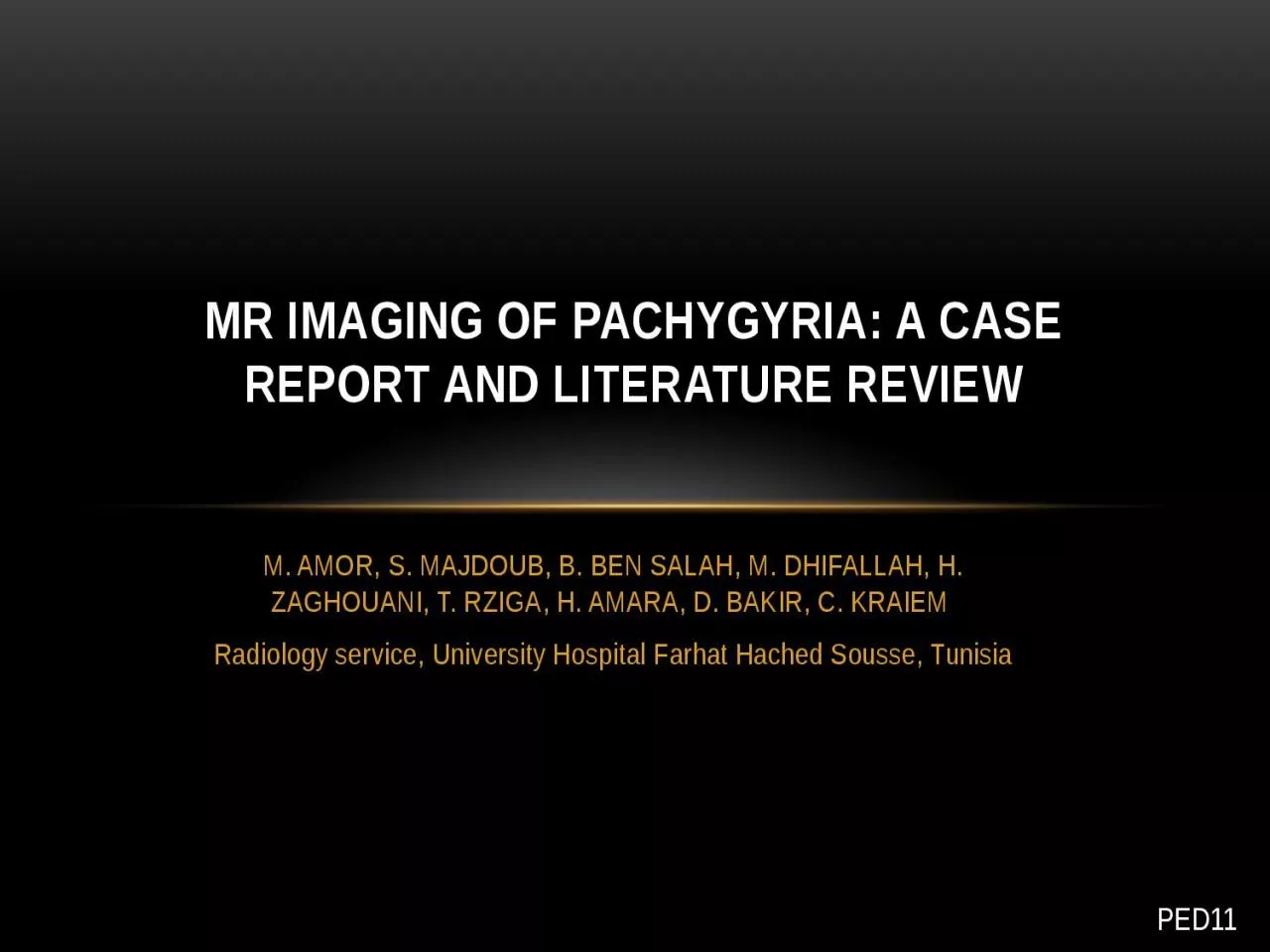

Radiology service University Hospital Farhat Hached Sousse Tunisia MR IMAGING OF PACHYGYRIA A CASE REPORT AND LITERATURE REVIEW PED11 OBJECTIVES MRI manifestations of pachygyria ID: 929730
Download Presentation The PPT/PDF document "M. AMOR, S. MAJDOUB, B. BEN SALAH, M. DH..." is the property of its rightful owner. Permission is granted to download and print the materials on this web site for personal, non-commercial use only, and to display it on your personal computer provided you do not modify the materials and that you retain all copyright notices contained in the materials. By downloading content from our website, you accept the terms of this agreement.
Slide1
M. AMOR, S. MAJDOUB, B. BEN SALAH, M. DHIFALLAH, H. ZAGHOUANI, T. RZIGA, H. AMARA, D. BAKIR, C. KRAIEM Radiology service, University Hospital Farhat Hached Sousse, Tunisia
MR IMAGING OF PACHYGYRIA: A CASE REPORT AND LITERATURE REVIEW
PED11
Slide2OBJECTIVESMRI manifestations of pachygyria
are presented with a review of the pathological features of the disorder and an evaluation of the diagnostic value of imaging modalities.
Slide3Materials and methodsWe reported a case of
pachygyria brain in a 1 month-old girl with recurrent convulsive
seizures and axial
hypotonia
.
T
ransfontanellar
sound and
brain MRI using
axial FLAIR, diffusion,T2-weighted and coronal, sagittal T1-weighted, and
MPR 3D sequences with
multiplanar
reformations was performed
.
Slide4RESULTS
Transfontanellar ultrasound showed signs of leukodystrophy.MR
imaging demonstrate patterns of
pachygyria
, including:
Smooth and markedly thickened cortex Broad, widespread flat
gyri
with shallow sulci Vertically-oriented and shallow
Sylvian
fissures and the white matter is reduced in
proportion (figure 1, 2, 3 and 4)
Slide5Figura 1
: axial FLAIR
sequences
Slide6Figure 2:
axial T2-weighed
sequences
Slide7RESULTSAbsence of leukodytrophy
, areas of myelination in the cerebellum, pons
,
posterior
limb
of the
internal
capsule and thalamus
with
high
signal on FLAIR-
weighted
MR images (figure 1)
Mega
cisterna
magna (figure 3)
Slide8Figure 3
: sagittal T1-weighned
Figure 4
: coronal T1-weighned
Slide9DISCUSSIONAdvances in neuroimaging techniques have resulted in an increasing recognition of the cortical lesions as the etiology of a number of epilepsies that were previously defined as
cryptogenic.Agyria-pachygyria is a disease of neuronal migration characterized by the total or partial absence of sulci and a thickened cortical mantle.
Slide10DISCUSSIONIn many cases,
agyria and pachygyria coexist in the same patient. They represent degrees of the same fundamental disorders in cell migration and cortical organization.
More
and more patients have been documented as
agyria-pachygyria
since the advent
of CT scan
and
MRI.
Although some of these disorders have a genetic basis, the cause of the
migrational
arrest is still unknown.
Slide11DISCUSSION Pachygyria is considered the less severe form and exhibits a broader spectrum of clinical features than
agyria.It is a rare developmental disorder resulting from the abnormal migration of neurons in the developing brain and nervous system.
the
gyri
are relatively few are are usually broad and flat. The condition is also known as "incomplete
lissencephaly
".
It is a milder variant of
lissencephaly
, and part of the
lissencephaly
spectrum of
disorders.
Slide12DISCUSSIONMRI is commonly used for diagnosis. It provides a high contrast image for better delineation of white and gray matter
. Pachygyria shows on an MRI as thickened cerebral cortices with few and large gyri
and incomplete development of
Sylvian
fissures
.
The prognosis for children with
pachygyria
varies depending on the degree of brain abnormality and subsequent neurological signs and symptoms.
Slide13CONCLUSIONPachygyria is
a neuronal migration disorder characterized by reduced and
broad
cerebral
gyri
. The
regions
of the
brain
with
pachygyria
have an
abnormally
thick
cortex
that
lacks
normal
folding
and has
deficient
layering
the onset and severity depending on the severity of the cortical malformation
.
Infantile spasms are common in affected children, as is intractable epilepsy.
Neuroblast
migration disorders are better known, mainly due to high resolution MRI techniques that by the quality of
multiplanar
study and a better differentiation between gray and white matter, allow a more precise diagnosis.